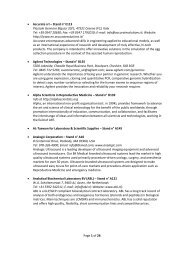REGULATORY NEWS// UPDATES FROM THE MINISTRIES //Denmark reverses its decisionon IVF medication co-paymentJust 12 months after introducing a patient co-payment system for ARTmedication and a treatment fee at all public clinics, the Danishgovernment has gone back to its old system of free access for up tothree completed IVF cycles and (almost) full reimbursement formedication. The revised system will come into force this month.In explaining the move the government said ‘the public health systemshould be characterised by equal access for everybody’ and that ‘copaymentfor assisted reproduction will lead to social inequality anddiscrimination against less wealthy patients’.The introduction of payment in 2011 prompted protests from allhealth professionals, who forecast that the move would result in fewerchildren born in Denmark and would compromise safety and research.However, the immediate effect was a 23% drop in the number ofIVF/ICSI treatments performed at the public clinics and a 30% drop inreferrals. With Danish clinics now responsible for around 10% of allchildren born, the effect on Danish birth rates would be marked.Whilst t<strong>here</strong> was a common perception in Denmark - as elsew<strong>here</strong> -that infertility was increasingly the result of lifestyle choices, we wereable to show in arguing against the co-payment scheme that in morethan 90% of all cases treated in the public system the cause of infertilitywas related to a disease defined as a registered diagnosis by theNational Board of Health.Further, it was shown (as described by Connolly et al in HumanReproduction 2011) that a decline in IVF babies would result in a netloss in tax revenue for Denmark when the perspective shifted to thelong term. We were also supported in our protests by the patientorganisations, who organised Facebook pages which attracted morethan 30,000 friends, all objecting to the introduction of patientpayment. Thus, the new Danish Government confirmed in October that‘in order to ensure that infertility patients are not treated worse thanother patients’ the system of co-payment for assisted reproduction,sterilisation and re-fertilisation would be revoked.Søren Ziebe, Rigshospitalet, Copenhagen. . . while Catalonia ends free access to fertilitydrugs for patients in the private sectorCiting Spain’s critical financial situation as an explanation, healthauthorities in the four provinces of Catalonia have discontinued theprovision of free fertility drugs for IVF patients in the private sector.Since 1997 the cost of all drugs for fertility treatment was reimbursed bythe Catalan health services, regardless of whether patients were treated inthe private or public system. Free access continues in the public sector.Policy in the Czech Republic is also to reimburse the full costs of threecycles, whether in the private or public sector, with a co-payment ofaround €1900. However, t<strong>here</strong> are new proposals that from January thisyear reimbusement with co-payment will be extended to four cycles oncondition that the patient accepts SET for the first two cycles.UK’s HFEA agrees fixedsum compensation for allgamete donationFollowing a public consultation andmany months of public agonising,Britain’s regulator, the HumanFertilisation and Embryology Authority,agreed in October to compensate spermdonors a fixed sum of £35 per visit andegg donors a fixed sum of £750 percycle of donation. The move, said theHFEA, was ‘a proactive approach todonor recruitment, retention and care’which provides donors with a level ofcompensation ‘which better reflects theirexpenses’ and their inconvenience.So far, UK policy had allowed spermand egg donors to claim only‘reasonable’ expenses, such as travelcosts, and a modest daily amount forloss of earnings, with a limit of £250 foreach course of sperm or egg donation.In announcing the one-off fee, theHFEA was at pains to remove any hint ofpayment or inducement from the newpolicy; this was strictly compensation,based, according to the HFEA, on theprecedence models of Denmark (forsperm donation) and Spain (for eggdonation).The Chair of the HFEA said that thelevel of compensation would ‘not deterthose interested in donation’ but would‘retain donors already in the system,without attracting those who are merelyfinancially motivated’.UK treatments using donor eggs hadfallen to a recent all-time low in 2009 ofjust 1254 cycles and the HFEA clearlythought that ‘compensation’ was one wayto resolve the ‘crisis’.The HFEA’s announcement also gaveits seal of approval to egg-sharing, atechnique which in its consultation hadbeen described as ‘controversial’. Thissystem of ‘benefits in kind’, said theHFEA, which is now well established inBritain, ‘should be allowed to continue’as before.8 Focus on Reproduction January 2012
Almost one in five women having IVF in UK is40 or over; but treatments continue to riseThe UK’s latest report on IVF activity for 2010shows that almost 20% of all fresh IVF and ICSIcycles performed in Britain were in women aged 40or over. The figures represent a considerableincrease, having almost doubled over the past 13years, and are thought likely to be replicated inmany other European countries.A recent study from Maastricht foundthat the average age of patientsattending a first consultationincreased from 27.7 years in1985 to 31.4 years in 2008,a rise of almost four yearsin just two decades. Theproportion of women of35 years or older almostquadrupled to 31%.And world datagat<strong>here</strong>d by ICMART for2007 and reported atESHRE’s annual meetinglast year estimated thatalmost 16% of women havingART were over the age of 40.The latest HFEA report puts theaverage age of women in the UK having IVF andICSI (as well as donor insemination) in 2010 at35 years. Twenty years ago, the average age was33.6 years.The report also disclosed that in 2010 a totalof 45,264 women received 57,652 IVF or ICSItreatments, an increase of 5.9% on thenumber of cycles in 2009. This toois consistent with recent year-onyeartrends calculated byESHRE’s EIM Consortiumand by ICMART.The pregnancy ratefrom these UK cycleswas 33.4% per transfer.However, in 200924.9% of live births inpatients aged 18–34years were multiple, arate only marginallylower than the 29.4%multiple rate of 2008.Age range of IVF/ICSI patients in UK clinics in2010, from the HFEA’s latest annual report.Netherlands poised to reduce reimbursed IVF cyclesHolland’s minority government (of liberals and Christian Democrats) has been in power for little more than a year but hasalready announced cost-cutting measures in IVF to the tune of €30 million a year. This, they say, must be achieved byexcluding a second and third cycle from the state’s reimbursement scheme - which would reduce the number of reimbursedIVF cycles in the Netherlands from three to one. In announcing the measures, the government invited those involved topropose alternative ways to raise the €30 million a year.‘We calculated that the additional cost of a twin pregnancy compared to a singleton was around €5000 per pregnancy,’said Hans Evers, from the Academic Hospital of Maastricht. ‘The extra costs involved in the delivery and in the first fourweeks range from €2000 in the case of a healthy twin to €30,000 in the case of a twin with complications, such asprematurity.’ Evers added that the long-term costs submitted to the government were only rough estimates, but rangedfrom €900-7000 per year per child with a minor handicap to €1800-20,000 per year per child with a severe handicap.The Dutch calculations were based on 2009 data; 16,769 IVF treatment cycles were performed, resulting in 4386ongoing pregnancies and 469 twin pregnancies, for a multiple pregnancy rate of 10.7%. Of these twins, 85% were born towomen below 38 years of age.‘Estimating the average lifetime additional costs of a twin at € 75,000,’ explained Evers, ‘we argued that by decreasingthe number of twins to zero by performing single embryo transfer in all women below 38 years, we would save 85% x 469twins x €75,000 per year - that’s €29.9 million. We thought this would meet the government’s requirements, which wouldleave the number of reimbursed cycles at three.’However, despite the logic of the proposal and the clinics’ promise to adopt a strategy of only SETs in all women under38, the Minister of Health was not impressed. The cost savings would be made outside the area of IVF, and many of thecost savings were considered ‘lifetime’, so would not bring an immediate return. The signs are, says Evers, that theNetherlands will now lose its three cycle reimbursement policy in 2013, and become yet another example of how IVFseems the soft option when it comes to cost-cutting in health budgets.Focus on Reproduction January 2012 9
















